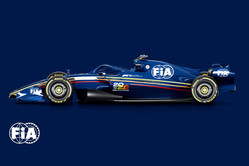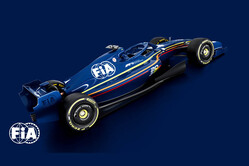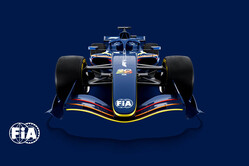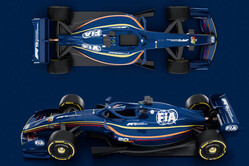 The FIA today showcased a more competitive, safer and more sustainable future for the Formula One World Championship with the presentation of the much anticipated technical regulations that will define the sport from 2026 onwards.
The FIA today showcased a more competitive, safer and more sustainable future for the Formula One World Championship with the presentation of the much anticipated technical regulations that will define the sport from 2026 onwards.
Developed in consultation with the FIA Formula 1 Technical Working Groups, and formulated in collaboration with Formula 1, the sport's ten teams, OEMs and power unit manufacturers, outline details of the new regulations were revealed in Montreal ahead of this weekend's Canadian Grand Prix.
The 2026 regulations are now set to be officially ratified by the World Motor Sport Council on June 28.
"Today, the FIA is defining a hugely exciting future for the pinnacle of motorsport with the launch of a comprehensive new set of regulations for the 2026 FIA Formula One World Championship and beyond," said FIA President, Mohamed Ben Sulayem.
"Following the publication of 2026 Power Unit Regulations two years ago we have taken the opportunity to redefine the chassis regulations to match the energy requirement of the new power units. Collaborating with our partners at Formula 1 and with the assistance of the sport's ten teams and all our stakeholders this represents a unique revision that will ensure our premier championship is even more relevant to what is happening in the world.
"The Power Unit Regulations have already resulted in a record number of PU manufacturers committing to the sport. And now, in tandem with chassis regulations that provide for lighter, more agile cars featuring innovative aerodynamic solutions, we have created a set of regulations designed to not only improve racing but also to make the championship even more attractive to PU manufacturers, OEMs and existing competitors. The key features of the 2026 F1 Regulations are advanced, sustainability technology and safety. Our aim, together with Formula 1, was to produce a car that was right for the future of the sport's elite category. We believe we have achieved that goal."
 "These regulations mark a significant moment in the future of our sport as we look forward to a new generation of car and power unit that aims to give our fans closer and exciting racing," added Formula 1 CEO, Stefano Domenicali. "The new sustainably fuelled hybrid power unit presents a huge opportunity for the global automotive industry, the drop in fuel has the potential to be used by cars around the world and dramatically cut emissions. Its potential is one of the key reasons why we will have a record number of engine suppliers in Formula 1 in 2026.
"These regulations mark a significant moment in the future of our sport as we look forward to a new generation of car and power unit that aims to give our fans closer and exciting racing," added Formula 1 CEO, Stefano Domenicali. "The new sustainably fuelled hybrid power unit presents a huge opportunity for the global automotive industry, the drop in fuel has the potential to be used by cars around the world and dramatically cut emissions. Its potential is one of the key reasons why we will have a record number of engine suppliers in Formula 1 in 2026.
"We enter this new regulatory cycle with the sport in the strongest position it has ever been, and I am confident that the work done by the FIA to create these regulations will further strengthen the position of the sport around the world."
"With this set of regulations the FIA has sought to develop a new generation of cars that are fully in touch with the DNA of Formula 1," said FIA Single Seater Technical Director, Nikolas Tombazis, "cars that are light, supremely fast and agile but which also remains at the cutting edge of technology, and to achieve this we worked towards what we called a 'nimble car' concept. At the centre of that vision is a redesigned power unit that features a more even split between the power derived from the internal combustion element and electrical power.
"On the chassis side we have managed to reduce the size and weight of the car by 30kg resulting in a much more dynamic car. In addition we are introducing two exciting new features to enhance racing - active aerodynamics to achieve very low drag on the straights and the Manual Override system that will provide drivers with an on-demand burst of battery power when close enough to the car ahead of them.
"Lighter, more powerful and more focused on driver skill, the 2026 FIA Formula 1 Technical Regulations have been designed to provide closer racing among drivers, increase the competition between teams and improve the spectacle. In addition, we have opted for a higher electrical component of the power unit, a more efficient car overall, and fully sustainable fuels, as part of our drive towards a more sustainable future for our sport."
 The full set of 2026 regulations take Formula 1 into the future via a number of key innovations across power unit, chassis, aerodynamics, safety and sustainability.
The full set of 2026 regulations take Formula 1 into the future via a number of key innovations across power unit, chassis, aerodynamics, safety and sustainability.
Power Unit
First published in August 2022, the power unit regulations provide for a major leap forward. Building on the foundations of the world's most efficient hybrid engine currently used in Formula 1, the 2026 power unit delivers even more power than the current PUs. While the power derived from the ICE element drops from 550-560kw to 400kw, the battery element increases massively, from 120kw to 350kw - an almost 300% increase in electric power. Performance is therefore maintained, while sustainability is increased even further.
By simplifying the power unit through the removal of the MGU-H and the expansion of electrical power, the 2026 power is the most road relevant yet seen in Formula 1, and in tandem with 100% sustainable fuel provides a forward-thinking platform for transferrable future innovation.
Additionally, the amount of energy that can be recuperated during braking is doubled, resulting in a total recuperable energy of 8.5 MJ per lap.
A Manual Override mode has been included to create improved overtaking opportunities. While the deployment of a leading car will taper off after 290kph, reaching zero at 355kph, the following car will benefit from MGUK Override providing 350kW up to 337kph and +0.5MJ of extra energy.
Designed to attract new manufacturers to the sport, the regulations have led to commitments from existing suppliers such as Ferrari, Mercedes and Alpine, the return of Honda as a manufacturer and the arrival of Audi and Red Bull Ford Powertrains.
 Chassis
Chassis
Designed to be smaller and lighter than the current generation of cars, the dimensions of the car have been altered to adhere to the 'nimble car' concept at the heart of the new rules. The wheelbase drops from a maximum of 3600mm to 3400mm, while the width has been reduced from 2000mm to 1900mm. The maximum floor width will be reduced by 150mm.
Weight reduction has been a key goal and 2026 cars will have a minimum weight of 768kg - down 30kg on their counterparts from 2022. This is made up of 722kg Car and Driver + 46kg estimated tyres mass.
Downforce has been reduced by 30% and drag by 55%.
The 18-inch wheel size introduced in 2022 is being retained, though the width of the front tyres has been reduced by 25mm and the rears by 30mm but with minimal loss in grip.
Aerodynamics
The 2026 cars will also benefit from all-new Active Aerodynamics systems. The system, involving movable front and rear wings, will result in greater cornering speeds with standard Z-Mode deployed. On straights drivers will be able to switch to X-Mode a low-drag configuration designed to maximise straight-line speed.
A three-element active rear wing will be adopted, while the lower beam wing has been removed and end plates have been simplified.
The front wing will be 100mm narrower than currently and will feature a two-element active flap.
In contrast to the current cars, front wheel arches will be removed, and part of the wheel bodywork will be mandated, to help achieve optimal wake performance.
In-washing wheel wake control boards will sit on the front of the side pods to assist with the control of the wheel wake.
The cars will feature a partially flat floor and a lower-powered diffuser, which will reduce the ground effect and the reliance of the cars on ultra-stiff and low set-ups.
 Safety
Safety
The FIA's rigorous pursuit of safety is upheld in the 2026 Formula 1 regulations.
Revised front impact regulations introduce a two-stage structure to avoid incidents in recent years where the front impact structure (FIS) has broken-off close to the survival cell after an initial impact, leaving the car unprotected for a subsequent impact.
Side intrusion protection has been increased. The new specification gives improved intrusion protection around the cockpit and more than doubles the protection given by the side of the fuel cell. Additionally, the improved intrusion protection will be achieved without adding weight.
Roll hoop loads have been increased from 16G to 20G in line with other single seater formulas and test loads increased from 141kN to 167kN.
Rear wing endplate lights will be homologated and significantly more visible/bright than current ones. Lateral safety lights will be introduced to identify the ERS status of a car stopped across the track.
The GPS antenna is being repositioned to improve sensitivity and to allow for future developments in active safety.
Sustainability
From 2026 Formula 1 power units will run on fully sustainable fuel, underscoring the commitment to environmentally responsible racing and setting a new standard for motorsport.
This fuel will be 'drop-in', meaning it can be used in almost any ICE-powered vehicle, offering a potentially game-changing solution to greenhouse gasses in the transportation sector. By 2030 there will be 1.2bn ICE cars on the road worldwide and the fuel developed for Formula 1 could be used to reduce emissions on an industrial scale.
Sustainability will be enhanced through greater use of electric power in the 2026 power units and a shift to towards a 50% electrical and 50% thermal power distribution.
The 2026 regulations are in line with the FIA objective of reaching Net Zero carbon by 2030.
The 2026 regulations are now set to be officially ratified by the World Motor Sport Council on June 28.


























sign in